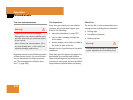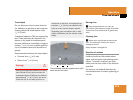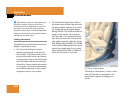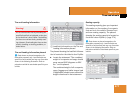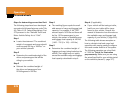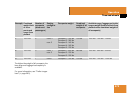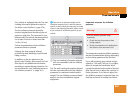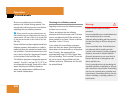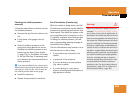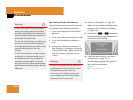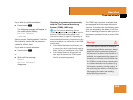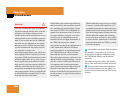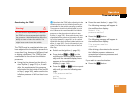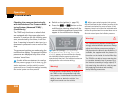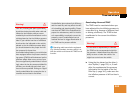
382
Operation
Tires and wheels
Be sure to readjust the tire inflation
pressure for normal driving speeds. You
should wait until the tires are cold before
adjusting the tire inflation pressure.
Some vehicles may have supplemental tire
inflation pressure information for vehicle
loads less than the maximum loaded vehi-
cle condition. If such information is provid-
ed, it can be found on the placard located
on the inside of the fuel filler flap.
Tire inflation pressure changes by approxi-
mately 1.5 psi (0.1 bar) per 18°F (10°C) of
air temperature change. Keep this in mind
when checking tire inflation pressure
where the temperature is different from
the outside temperature.
Checking tire inflation pressure
Regularly check your tire inflation pressure
at least once a month.
Check and adjust the tire inflation
pressure when the tires are cold. The tires
can be considered cold if the vehicle has
been parked for at least 3 hours or driven
less than 1 mile (1.6 km).
If you check the tire inflation pressure
when the tires are warm (the vehicle has
been driven for several miles or sitting less
than 3 hours), the reading will be
approximately 4 psi (0.3 bar) higher than
the cold reading. This is normal. Do not let
air out to match the specified cold tire
inflation pressure. Otherwise, the tire will
be underinflated.
i
Driving comfort may be reduced when the
tire inflation pressure is adjusted to the value for
speeds above 100 mph (160 km/h) as specified
on the placard located on the inside of the fuel
filler flap.
Warning! G
Follow recommended tire inflation
pressures.
Do not underinflate tires. Underinflated tires
wear excessively and/or unevenly,
adversely affect handling and fuel economy,
and are more likely to fail from being over-
heated.
Do not overinflate tires. Overinflated tires
can adversely affect handling and ride
comfort, wear unevenly, increase stopping
distance, and result in sudden deflation
(blowout) because they are more likely to
become punctured or damaged by road
debris, potholes etc.
Do not overload the tires by exceeding the
specified load limit as indicated on the plac-
ard on the driver’s door B-pillar. Overloading
the tires can overheat them, possibly caus-
ing a blowout. Overloading the tires can also
result in handling or steering problems, or
brake failure.



